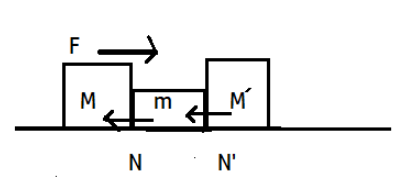
A constant force F is applied in a horizontal direction as shown. The contact force between M and m is N and between m and M’ is N’ then:

(A) N=N’
(B) N>N’
(C)N’>N
(D) cannot be determined from the given data

Answer
566.7k+ views
Hint: Here we have three bodies of given masses and placed close to each other in contact. The floor is smooth and there is no scope of any frictional force present. A constant force F acts on the first body and we need to find the force between the masses. Newton’s third law of motion can be used here.
Complete step by step answer:

Since F acts on the M and this is constant, if we see the whole system then the total mass of the system is (M+m+M’)
Applying Newton’s second law we get, F=(M+m+M’)a
\[a=\dfrac{F}{M+m+M'}\]
Between M and m contact force is N, applying Newton’s third law
\[N=\dfrac{(m+M')F}{M+m+M'}\]-----(1)
Between m and M’ contact force is N’, applying Newton’s third law \[N'=\dfrac{M'F}{M+m+M'}\]----(2)
Comparing the above two it is visible that numerator of (1) is greater than the numerator of (2) while the denominators are same, so, N>N’
Hence, the correct option is (B).
Note:Newton’s second law states that force applied on a body is equal to the product of the mass of the body and acceleration produced in the body. If the external force is zero, then the acceleration of the body is zero. Newton’s third law states that forces always occur in pairs.
Complete step by step answer:

Since F acts on the M and this is constant, if we see the whole system then the total mass of the system is (M+m+M’)
Applying Newton’s second law we get, F=(M+m+M’)a
\[a=\dfrac{F}{M+m+M'}\]
Between M and m contact force is N, applying Newton’s third law
\[N=\dfrac{(m+M')F}{M+m+M'}\]-----(1)
Between m and M’ contact force is N’, applying Newton’s third law \[N'=\dfrac{M'F}{M+m+M'}\]----(2)
Comparing the above two it is visible that numerator of (1) is greater than the numerator of (2) while the denominators are same, so, N>N’
Hence, the correct option is (B).
Note:Newton’s second law states that force applied on a body is equal to the product of the mass of the body and acceleration produced in the body. If the external force is zero, then the acceleration of the body is zero. Newton’s third law states that forces always occur in pairs.
Recently Updated Pages
Why are manures considered better than fertilizers class 11 biology CBSE

Find the coordinates of the midpoint of the line segment class 11 maths CBSE

Distinguish between static friction limiting friction class 11 physics CBSE

The Chairman of the constituent Assembly was A Jawaharlal class 11 social science CBSE

The first National Commission on Labour NCL submitted class 11 social science CBSE

Number of all subshell of n + l 7 is A 4 B 5 C 6 D class 11 chemistry CBSE

Trending doubts
What is meant by exothermic and endothermic reactions class 11 chemistry CBSE

1 Quintal is equal to a 110 kg b 10 kg c 100kg d 1000 class 11 physics CBSE

What is periodicity class 11 chemistry CBSE

What is a periderm How does periderm formation take class 11 biology CBSE

Mention the basic forces in nature class 11 physics CBSE

What are porins class 11 biology CBSE




